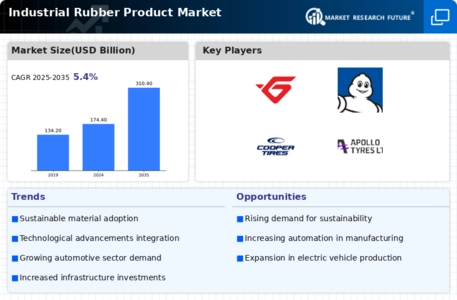Market Growth Projections
The Global Industrial Rubber Product Market Industry is projected to witness substantial growth, with estimates indicating a rise from 174.4 USD Billion in 2024 to 310.4 USD Billion by 2035. This growth trajectory suggests a compound annual growth rate of 5.38% from 2025 to 2035, reflecting the increasing demand for rubber products across various sectors. The market's expansion is likely to be fueled by factors such as technological advancements, rising consumer awareness regarding sustainability, and the ongoing development of infrastructure worldwide. These projections highlight the industry's potential and the opportunities that lie ahead.
Expansion of End-User Industries
The expansion of end-user industries such as construction, healthcare, and consumer goods is driving the Global Industrial Rubber Product Market Industry. As these sectors grow, they require a diverse range of rubber products for various applications. For example, the construction industry relies on rubber for insulation, flooring, and sealing solutions, while the healthcare sector utilizes rubber in medical devices and protective equipment. This broadening of applications is expected to contribute to a compound annual growth rate of 5.38% from 2025 to 2035, indicating a robust future for the market as it adapts to the evolving needs of diverse industries.
Growing Demand from Automotive Sector
The automotive sector is a primary driver of the Global Industrial Rubber Product Market Industry, as rubber components are essential for vehicle manufacturing. With the global automotive market projected to reach 174.4 USD Billion in 2024, the demand for rubber products such as tires, seals, and gaskets is expected to rise significantly. This growth is attributed to the increasing production of electric vehicles and the need for enhanced performance materials. As automotive manufacturers prioritize durability and safety, the demand for high-quality rubber products is likely to expand, contributing to the overall growth of the market.
Infrastructure Development Initiatives
Infrastructure development initiatives across various regions are propelling the Global Industrial Rubber Product Market Industry. Governments are investing heavily in transportation, energy, and urban development projects, which require a wide range of rubber products. For instance, the construction of roads, bridges, and railways necessitates the use of rubberized materials for durability and flexibility. As these projects gain momentum, the market is expected to benefit from increased demand for rubber products, thereby supporting a projected market growth to 310.4 USD Billion by 2035. This trend indicates a robust future for the industry, driven by public and private sector investments.
Rising Demand for Sustainable Products
The rising demand for sustainable products is reshaping the Global Industrial Rubber Product Market Industry. Consumers and industries are increasingly prioritizing eco-friendly materials, prompting manufacturers to innovate with sustainable rubber solutions. This shift is evident in the growing use of recycled rubber and bio-based materials in various applications, including automotive and construction. As regulations tighten and environmental awareness increases, the market is likely to experience a surge in demand for sustainable rubber products. This trend not only supports environmental goals but also opens new avenues for growth, as companies that adapt to these demands may gain a competitive edge.
Technological Advancements in Manufacturing
Technological advancements in manufacturing processes are significantly influencing the Global Industrial Rubber Product Market Industry. Innovations such as automation, 3D printing, and advanced compounding techniques enhance production efficiency and product quality. These developments allow manufacturers to create specialized rubber products tailored to specific applications, thus expanding market opportunities. As companies adopt these technologies, they can reduce costs and improve sustainability, which is increasingly important in today's market. The integration of smart manufacturing practices is likely to drive growth, as it aligns with the industry's shift towards more efficient and environmentally friendly production methods.















